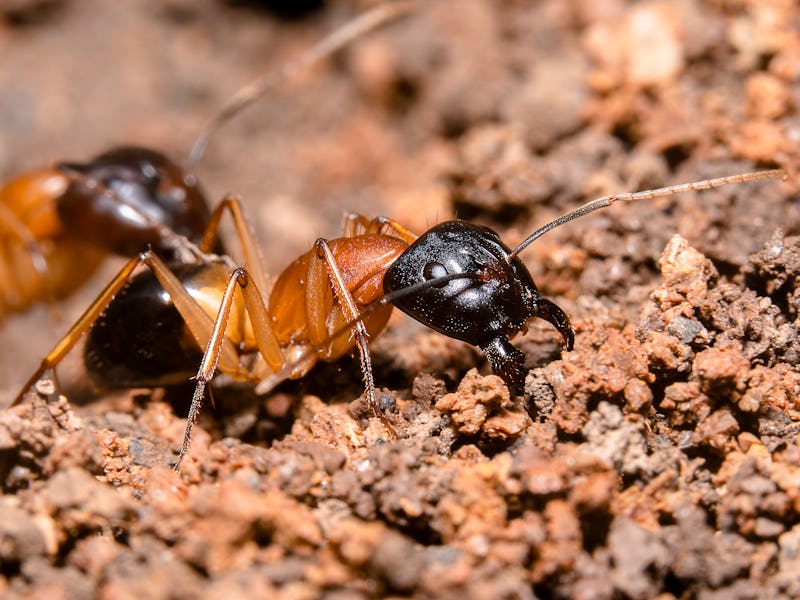Pee-eating ants may be the climate heroes we need right now
Australian sugar ants have a neat trick for feeding themselves — and helping the climate.

What food is sweeter than sugar? Urine.
At least, if you are an Australian sugar ant, that is.
Sugar ants, Camponotus terebrans, are named for their taste for sweetness. But an experiment conducted by Australian researchers reveals that the ants actually prefer chowing down on something a little less sugary and much more strange.
How the scientists stumbled upon this weird predilection is rather odd in itself. In what may be one of the strangest study designs of all time, the scientists exposed sugar ants to different concentrations of urine taken from humans and kangaroos, sugar water, and a mix of water and urea — essentially the nitrogen in your pee — to see which the ants preferred.
Despite their name, the ants are most attracted to food with the highest concentrations of urea.
Food choices aside, the sugar ant may be a key player in the natural world's fight against climate change.
Scientists already knew that ants are attracted to urine, but these new findings are the first time ants have been observed harvesting dry urine from sand — and choosing to do so over a long spell of time. And, even stranger, the behavior could be an unexpected boon in the fight to curb global warming.
The results appeared in December in the journal Austral Ecology.
Pee mining: Good for ants, good for the Earth
Mining urine from sand confers an unexpected nutritional benefit to the ants, the researchers say. That's because they live in a desert environment, where essential nutrients like nitrogen are difficult to come by. Feasting on pee from vertebrate animals like kangaroos gives the ants the nutrients they need without having to leave their chosen home. It may even give them an upper hand on other, competing ant species.
"The ability of sugar ants to thrive in dry, sandy environments and use sources of nitrogen that may not be available to other species is impressive,” said Topa Petit, an associate professor at the University of South Australia and study author, in a statement.
“It may give them a competitive advantage by allowing them to feed more offspring and therefore increase their numbers."
More remarkably, their pee-munching ways have a silver lining for the climate, too.
Removing nitrogen-rich urine from sand — and thus preventing it from entering the atmosphere — can benefit the environment.
When nitrogen in pee breaks down after being exposed to the air, it creates nitrous oxide gas. And nitrous oxide — a nitrogen-oxygen chemical compound often found in fertilizers — is an incredibly powerful greenhouse gas. While it’s less abundant than carbon dioxide, the more-infamous of the greenhouse gases, pound-for-pound nitrous oxide's contributions to global warming are 300 times greater.
It is a bit premature to start rounding up ants to solve the climate crisis, but it is still nice to know that these unusual bugs are hard at work making some impact on cutting emissions.
Abstract: The ability of some ant species (including Camponotus spp.) to forage on vertebrate urine to extract urea may extend their niche in competitive and strongly nitrogen‐limited environments. We examined the preference of Camponotus terebrans, a sand‐dwelling ant widespread in southern Australia, for baits including urine, and the duration of their foraging on those baits. We baited ants with liquid stains of urine (human and kangaroo), urea in water (2.5%. 3.5%, 7.0%, 10.0%) and sucrose in water (20% and 40%) poured directly on the ground, as well as hard baits in plots drawn on sandy soil (Kangaroo Island, South Australia). We counted individuals of this mostly nocturnal species to determine their attraction to different baits for one month. We checked plant growth on the plots after nine and 13 months. Ants collected insects and meat; they foraged for at least 29 days on stains. Ants were most numerous on 10% urea, followed by 7% urea, 3.5% urea, urine (which contains ~2.5% urea) and 2.5% urea, 40% sucrose and 20% sucrose; sucrose was less attractive to them than equimolar urea bait. Ants were attracted to human, kangaroo, and unidentified urines, and they collected bird guano. Baits and ant foraging did not affect plant recruitment in plots. We observed incidentally Camponotus consobrinus foraging on urine, which may be a common resource for this genus at the site. The remarkable ability of C. terebrans to extract nitrogen from dry sand over weeks explains partly its success on sandy soils. Foraging on urine may be an important strategy to address nitrogen limitation on sandy soils and exploit commensally niches in which hosts are kangaroos, wallabies and other vertebrates. The understanding of plant–vertebrate interactions must factor in the role of ants as commensal organisms. Such ants could also reduce greenhouse gas emissions from urine.